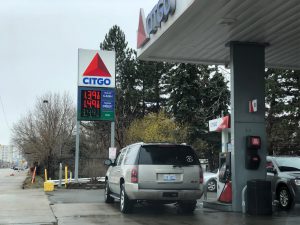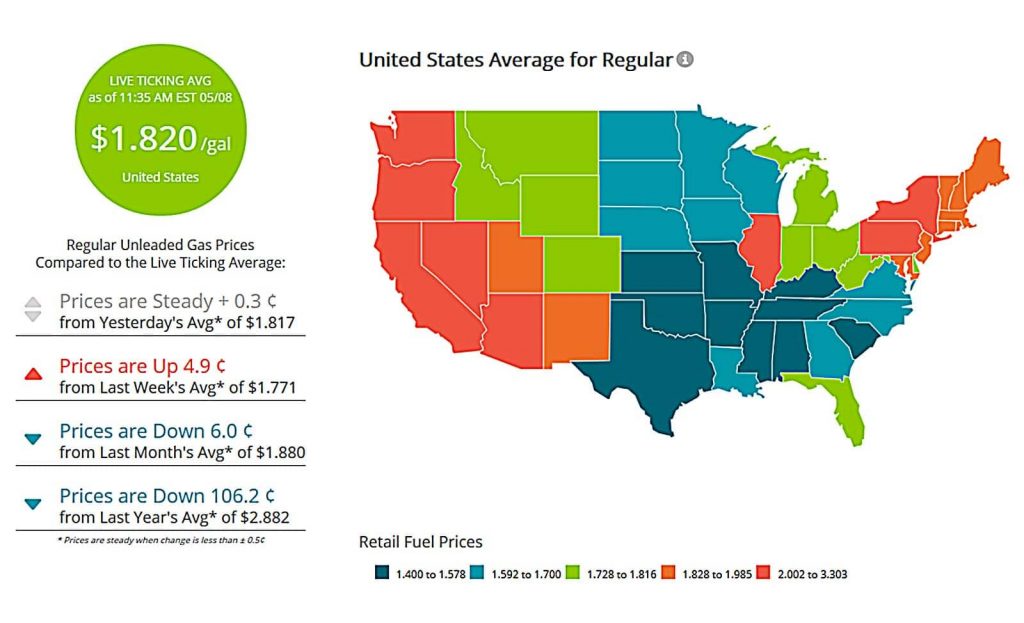
A Detroit gas station shows a price of just $1.39 a gallon – but some stations around the U.S. have dipped below $1 a gallon over the past month.
How low can it go? When it comes to gas prices, it seems, we already may have hit bottom and could be seeing the numbers start to rise again, just as large portions of the country are set to come out of coronavirus lockdown.
Both AAA and tracking company GasBuddy.com show that the cost of regular self-serve gasoline has been going up slightly, the two services agreeing that the typical American motorist is paying about $1.82 as of Friday morning, May 8. That’s up five cents from a week ago, according to AAA, with GasBuddy putting the rise at just over six cents.
“It’s becoming a bit clearer that those 99 cent per gallon gas prices from the COVID-19 pandemic are solidly behind us as gasoline demand rebounds across the country as cities and states slowly reopen,” he lowest priced stations in the country will see some upward movement, but most areas will still see declines,” said Patrick DeHaan, the director of petroleum analysis for GasBuddy.
That said, DeHaan doesn’t believe it’s all bad news, adding that, “The lowest priced stations in the country will see some upward movement, but most areas will still see declines.”
(MI Gov. Whitmer gives automakers greenlight to restart production.)
Several factors came together to drive down gas prices in the first place. For one thing, there was the bitter dispute between Saudi Arabia and Russia, two of the world’s largest oil producers, over proposed production cuts. Instead, the two countries began flooding the world with crude while other oil-producing nations refused to make major cuts of their own to compensate for the glut.

The glut of petroleum has become so severe many oil tankers can’t dock and unload their cargo of crude.
And things only got worse once the coronavirus outbreak in China spread to become a global pandemic. With the global economy taking a hit and residents of many countries, including the U.S., ordered to shelter in place, demand for petroleum products, especially gasoline, collapsed, even as supplies surged to record levels. The situation got so bad – for the oil industry, that is – that the price of crude briefly went into negative territory on some markets late last month.
And that brought prices to levels not seen in years in the U.S., some service stations in places like Michigan, Wisconsin and Oklahoma pumping regular for less than $1.00 a gallon.
Even now, AAA shows the average U.S. price for regular at self-service pumps is $1.06 less than the $2.88 motorists paid a year ago. GasBuddy puts the savings at $1.04. And if you’re that typical motorist you’ll still be paying at least a nickel less than a month ago.
(Rent-a-car companies slash orders, deliver another blow to automakers.)
Service stations in all but eight states are averaging less than $2.00 a gallon as of Friday morning, the two sources agree. Five are still averaging under $1.50. Oklahoma has the lowest average price of any state in the U.S., $1.39, according to GasBuddy, with Hawaii highest, at $3.09.
But the upward trend could continue. Start with the agreement between Russia and Saudi Arabia aimed at finally bringing global oil production down. That’s one reason crude prices have rebounded, albeit to still-depressed levels. WTI, or West Texas Intermediate hit $24 a barrel on Thursday, fully double the $12 price of a week before.
Now add the fact that Americans are beginning to spend more time in their cars again, and the trend will accelerate as more states end lockdowns. The latest report from the Energy Information Agency shows that U.S. demand for gasoline rose 800,000 barrels a day last week, to 6.7 million. That was a spectacular jump, though demand was still down 3.2 million barrels a day from year-ago levels, according to the EIA.
Nonetheless, “The optimism can now be sensed everywhere,” Germany’s Commerzbank wrote in an analysis released on Wednesday. That said, the bank’s analysts took a deep and cautioned, “We believe that the current euphoria on the oil market is premature.”
Stocks are still huge. There are still plenty of tankers at sea that can’t offload their shipments because there’s nowhere to store fresh crude.
And, on an economic level, the latest figures show U.S. unemployment at around 33 million. While some will be back to work as factories and businesses reopen, most economists expect the return to anything close to normal will be a long slog.
So, while you may find yourself paying a bit more for gas in the coming weeks, there seems little likelihood we’ll soon see the numbers at your local return to pre-pandemic levels any time soon.
(Congress might consider new auto bailout – or sales stimulus program.)


Leave it to good ‘ol Illinois to be the Midwest stand out in raising petrol prices. $2.25 on average and I’m in the sticks, major cities and subs like Chicago, Schaumburg are more.